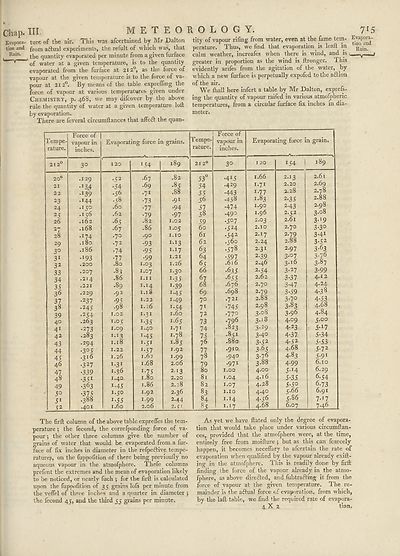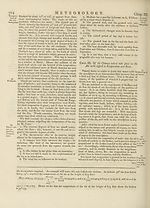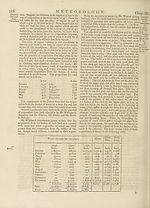Encyclopaedia Britannica, or, a Dictionary of arts, sciences, and miscellaneous literature : enlarged and improved. Illustrated with nearly six hundred engravings > Volume 13, MAT-MIC
(761) Page 715
Download files
Complete book:
Individual page:
Thumbnail gallery: Grid view | List view

Chap. HI
Evapora- ture of the air. This was afcertained by Mr Dalton
tion and from actual experiments, the refult of which was, that
^a^n‘ the quantity evaporated per minute from a given furface
,lJ"' v of water at a given temperature, is to the quantity
evaporated from the furface at 212°, as the force of
vapour at the given temperature is to the force of va¬
pour at 212°. By means of the table exprefling the
force, of vapour at various temperatures given under
Chemistry, p. 468, we may difcover by the above
rule the quantity of water at a given temperature loft
by evaporation.
There are feveral circumftances that affect the quan-
715
tity of vapour rifing from water, even at the fame tem- Evapora-
perature. Thus, we find that evaporation is leaft in
calm weather, increafes when there is wind, and is
greater in proportion as the wind is ftronger. This
evidently arifes from the agitation of the water, by
which a new furface is perpetually expofed to the a&ion
of the air.
We (hall here infert a table by Mr Dalton, exprefs-
ing the quantity of vapour raifed in various atmofpheric
temperatures, from a circular furface fix inches in dia¬
meter.
METEOROLOGY.
Tempe¬
rature.
212
20°
21
22
23
24
25
26
27
28
29
3°
31
32
33
34
35
36
37
38
39
40
41
42
43
44
45
46
47
48
49
5°
51
5 2
Force of
vapour in
inches.
3°
.129
•I34
•I39
•I44
.150
.156
.162
.168
.174
.180
.186
•'93
.200
.207
.214
.221
.229
•237
•245
•254
.265
•273
.283
.294
•3°5
.216
•327
•339
•35i
•363
•375
.388
.401
Evaporating force in grains.
Tempe¬
rature.
•5 2
•54
•56
•58
.60
.62
•65
.67
.70
.72
•74
•77
.80
.83
.86
.89
.92
•95
.98
1.02
1.05
1.09
1.18
1.22
1.26
1-31
1.36
1.40
I-45
1.50
I-55
1.60
154
.67
.69
•71
•73
•77
•79
.82
.86
.90
•93
•95
•99
1.03
x.c7
1.11
1.14
1.1 8
1.22
1.26
I*3I
I-35
1.40
I,45
I-5I
1-57
1.62
1.68
I-75
1.80
1.86
1.92
1.99
2.06
189
.82
.85
.88
.91
•94
•97
1.02
1.05
1.10
1.17
1.21
1.26
1.3°
I-35
I-39
i-45
1.49
I-54
1.60
1.65
1.71
1.78
1.85
1.92
1.99
2.06
2.13
2.20
2.28
2.36
2.44
2.Cl
21 2C
53
54
55
56
57
58
59
60
61
62
63
64
65
66
67
68
69
70
7T
72
73
74
75
76
77
78
79
80
81
82
83
84
85
Force of
vapour in
inches.
3°
A15
.429
•443
•458
•474
.490
•5°7
•524
•542
. c6o
•578
•597
.616
•635
•655
.676
.698
.721
•745
•77°
.796
.823
.851
.880
.910
.940
•971
1.00
1.04
1.07
1.10
1.14
1.17
Evaporating force in grain.
1.66
1- 7I
1.77
1.83
1.90
1.96
2.03
2.10
2.17
2.24
2.31
2- 39
2.46
2- 54
2.62
2.70
2.79
2.88
2.98
3.08
3.18
3- 29
3-40
3-52
3-65
3- 76
3.88
4.00
4.16
4.28
4.40
4- 56
4.68
r54
2.13
2.20
2.28
2-35
243
2-52
2.61
2.70
2-79
2.88
2- 97
3- °7
3.16
3-27
3-37
347
3-59
3-7°
3-83
3- 96
4*°9
4- 23
4-37
4- 52
4.68
4.83
4.99
5- I4
5-35
5-5°
5.66
5.86
6.07
189
2.61
2.69
2.78
2.88
2.98
3-°8
3il9
3-3°
341
3-52
3-63
3-76
3-87
3- 99
zj.* 12
4.24
4- 38
4- 53
4.68
4.84
5.00
i-1?
5- 34
5-53
5-72
5- 91
6.10
6.29
6- 54
6.73
6.91
7*I7
7.46
The firft column of the above table expreffes the tem¬
perature •, the fecond, the correfponding force of va¬
pour ; the other three columns give the number of
grains of water that would be evaporated from a fur¬
face of fix inches in diameter in the refpeftive tempe¬
rature,s, on the fuppofition of there being previoufly no
aqueous vapour in the atmofphere. Thcfe columns
prefent the extremes and the mean of evaporation likely
to be noticed, or nearly fuch *, for the firft is calculated
upon the fuppofition of 35 grains lofs per minute from
the veffel of three inches and a quarter in diameter }
the fecond 45, and the third 55 grains per minute.
As yet we have ftated only the degree of evapora¬
tion that would take place under various circumftan¬
ces, provided that the atmofphere were, at the time,
entirely free from moifture ; but as this can fcarcely
happen, it becomes neceffary to afcertain the rate of
evaporation when qualified by the vapour already exift-
ing in the atmofphere. This is readily done by firft
finding the force of the vapour already in the atmo¬
fphere, as above directed, and fubtrafting it from the
force of vapour at the given temperature. The re¬
mainder is the actual force of evaporation, from which,
by the laft table, we find the required rate of evapora-
4X2 tion.
Evapora- ture of the air. This was afcertained by Mr Dalton
tion and from actual experiments, the refult of which was, that
^a^n‘ the quantity evaporated per minute from a given furface
,lJ"' v of water at a given temperature, is to the quantity
evaporated from the furface at 212°, as the force of
vapour at the given temperature is to the force of va¬
pour at 212°. By means of the table exprefling the
force, of vapour at various temperatures given under
Chemistry, p. 468, we may difcover by the above
rule the quantity of water at a given temperature loft
by evaporation.
There are feveral circumftances that affect the quan-
715
tity of vapour rifing from water, even at the fame tem- Evapora-
perature. Thus, we find that evaporation is leaft in
calm weather, increafes when there is wind, and is
greater in proportion as the wind is ftronger. This
evidently arifes from the agitation of the water, by
which a new furface is perpetually expofed to the a&ion
of the air.
We (hall here infert a table by Mr Dalton, exprefs-
ing the quantity of vapour raifed in various atmofpheric
temperatures, from a circular furface fix inches in dia¬
meter.
METEOROLOGY.
Tempe¬
rature.
212
20°
21
22
23
24
25
26
27
28
29
3°
31
32
33
34
35
36
37
38
39
40
41
42
43
44
45
46
47
48
49
5°
51
5 2
Force of
vapour in
inches.
3°
.129
•I34
•I39
•I44
.150
.156
.162
.168
.174
.180
.186
•'93
.200
.207
.214
.221
.229
•237
•245
•254
.265
•273
.283
.294
•3°5
.216
•327
•339
•35i
•363
•375
.388
.401
Evaporating force in grains.
Tempe¬
rature.
•5 2
•54
•56
•58
.60
.62
•65
.67
.70
.72
•74
•77
.80
.83
.86
.89
.92
•95
.98
1.02
1.05
1.09
1.18
1.22
1.26
1-31
1.36
1.40
I-45
1.50
I-55
1.60
154
.67
.69
•71
•73
•77
•79
.82
.86
.90
•93
•95
•99
1.03
x.c7
1.11
1.14
1.1 8
1.22
1.26
I*3I
I-35
1.40
I,45
I-5I
1-57
1.62
1.68
I-75
1.80
1.86
1.92
1.99
2.06
189
.82
.85
.88
.91
•94
•97
1.02
1.05
1.10
1.17
1.21
1.26
1.3°
I-35
I-39
i-45
1.49
I-54
1.60
1.65
1.71
1.78
1.85
1.92
1.99
2.06
2.13
2.20
2.28
2.36
2.44
2.Cl
21 2C
53
54
55
56
57
58
59
60
61
62
63
64
65
66
67
68
69
70
7T
72
73
74
75
76
77
78
79
80
81
82
83
84
85
Force of
vapour in
inches.
3°
A15
.429
•443
•458
•474
.490
•5°7
•524
•542
. c6o
•578
•597
.616
•635
•655
.676
.698
.721
•745
•77°
.796
.823
.851
.880
.910
.940
•971
1.00
1.04
1.07
1.10
1.14
1.17
Evaporating force in grain.
1.66
1- 7I
1.77
1.83
1.90
1.96
2.03
2.10
2.17
2.24
2.31
2- 39
2.46
2- 54
2.62
2.70
2.79
2.88
2.98
3.08
3.18
3- 29
3-40
3-52
3-65
3- 76
3.88
4.00
4.16
4.28
4.40
4- 56
4.68
r54
2.13
2.20
2.28
2-35
243
2-52
2.61
2.70
2-79
2.88
2- 97
3- °7
3.16
3-27
3-37
347
3-59
3-7°
3-83
3- 96
4*°9
4- 23
4-37
4- 52
4.68
4.83
4.99
5- I4
5-35
5-5°
5.66
5.86
6.07
189
2.61
2.69
2.78
2.88
2.98
3-°8
3il9
3-3°
341
3-52
3-63
3-76
3-87
3- 99
zj.* 12
4.24
4- 38
4- 53
4.68
4.84
5.00
i-1?
5- 34
5-53
5-72
5- 91
6.10
6.29
6- 54
6.73
6.91
7*I7
7.46
The firft column of the above table expreffes the tem¬
perature •, the fecond, the correfponding force of va¬
pour ; the other three columns give the number of
grains of water that would be evaporated from a fur¬
face of fix inches in diameter in the refpeftive tempe¬
rature,s, on the fuppofition of there being previoufly no
aqueous vapour in the atmofphere. Thcfe columns
prefent the extremes and the mean of evaporation likely
to be noticed, or nearly fuch *, for the firft is calculated
upon the fuppofition of 35 grains lofs per minute from
the veffel of three inches and a quarter in diameter }
the fecond 45, and the third 55 grains per minute.
As yet we have ftated only the degree of evapora¬
tion that would take place under various circumftan¬
ces, provided that the atmofphere were, at the time,
entirely free from moifture ; but as this can fcarcely
happen, it becomes neceffary to afcertain the rate of
evaporation when qualified by the vapour already exift-
ing in the atmofphere. This is readily done by firft
finding the force of the vapour already in the atmo¬
fphere, as above directed, and fubtrafting it from the
force of vapour at the given temperature. The re¬
mainder is the actual force of evaporation, from which,
by the laft table, we find the required rate of evapora-
4X2 tion.
Set display mode to:
![]() Universal Viewer |
Universal Viewer | ![]() Mirador |
Large image | Transcription
Mirador |
Large image | Transcription
Images and transcriptions on this page, including medium image downloads, may be used under the Creative Commons Attribution 4.0 International Licence unless otherwise stated. ![]()
| Permanent URL | https://digital.nls.uk/192693943 |
|---|
| Attribution and copyright: |
|
|---|
| Description | Ten editions of 'Encyclopaedia Britannica', issued from 1768-1903, in 231 volumes. Originally issued in 100 weekly parts (3 volumes) between 1768 and 1771 by publishers: Colin Macfarquhar and Andrew Bell (Edinburgh); editor: William Smellie: engraver: Andrew Bell. Expanded editions in the 19th century featured more volumes and contributions from leading experts in their fields. Managed and published in Edinburgh up to the 9th edition (25 volumes, from 1875-1889); the 10th edition (1902-1903) re-issued the 9th edition, with 11 supplementary volumes. |
|---|---|
| Additional NLS resources: |
|

